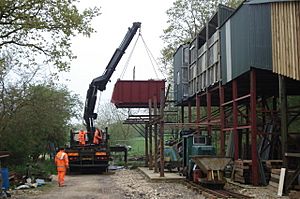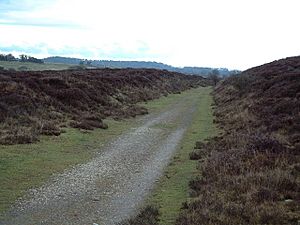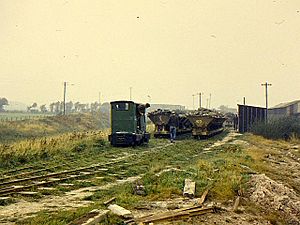Purbeck Mineral and Mining Museum facts for kids
The Purbeck Mining Museum helps us learn about the history of mining ball clay in the Isle of Purbeck. Ball clay is a special type of clay used to make pottery. The museum is located right next to Norden station on the Swanage Railway.
You can visit the museum from late March to late September. It is open on weekends, some weekdays, and Bank Holidays. The museum has moved an old mine building to Norden. They have also built a railway around the site. Many old wagons that worked on the lines around Norden have been fixed up.
One of the museum's future goals is to build a new home at Norden. This building will house Secundus, a special steam train. It will also display other old wagons and items. The new building will also have a library and a learning center for visitors.
The museum plans to make the narrow-gauge railway longer. It will extend to land owned by the group, going over Bridge 15. In 2010, engineers checked Bridge 15. They found it was in good shape for an old bridge built in 1885. However, the bridge was later badly damaged in an accident.
Contents
History of Purbeck Mining
Early Clay Transport: Middlebere Tramway
The Middlebere Tramway was an early railway. It was paid for by Benjamin Fayle. He was a friend of Thomas Byerley from Wedgwood, a famous pottery company. Fayle took over the clay pits to make sure Wedgwood had enough clay.
This railway was first called the "Iron Rail Way." It opened in 1806. It was designed by John Hodgkinson. The railway was 3 ft 9 in (1,143 mm) wide and about 5.6 kilometers (3.5 miles) long. It used L-shaped cast iron rails. Horses pulled the clay wagons, which had wheels without flanges. The railway used over 10,000 stone blocks as sleepers.
In 1807, the line was made longer to the south. It went under the road from Wareham to Corfe. The tunnel still exists but is blocked. Another tunnel was built in 1825, also now blocked. In 1881, the LSWR built the Swanage line. The Middlebere Tramway was then extended to transfer clay to the larger railway network. This tramway was used for 101 years before it closed in 1907.
Today, the old quay at Middlebere Creek is mostly gone. You can still find some stone sleepers from the railway. They have holes where the rails were attached. Some have been used as paving stones. You can also see parts of the old route across Hartland Moor.
Newton Tramway: Steam Power Arrives
In May 1854, another railway opened. It ran from the clay pits at Newton to Goathorn Pier. This pier was on South Deep in Poole Harbour. At first, horses pulled the wagons on this railway. It was 3 ft (914 mm) wide.
Around 1870, the railway was changed to 3 ft 9 in (1,143 mm) wide. This was to allow a steam locomotive to run on it. The engine was built by Stephen Lewin in Poole. It was named "Corfe" but was called "Tiny" because it was so small. "Tiny" became its real name. An engine shed was built at Newton for "Tiny." Water for the engine came from a well. Coal was brought by ship to Goathorn Pier.
In 1907, the Newton railway connected to Norden. Part of it became known as the "Fayles Tramway."
Fayles Tramway: Connecting the Mines
Around 1907, the Middlebere tramway stopped being used. A new railway link was built to Newton. This new line was 3 ft 9 in (1,143 mm) wide. It ran from Norden across the heath to join the Newton tramway. This gave a way to send clay out through Goathorn Pier. The line was about 9.2 kilometers (5.75 miles) long. Another locomotive was bought for this line.
This railway helped send clay from Norden through Goathorn Pier. It also allowed clay from Newton to leave Purbeck by train. In 1924, the railway was used to build the Training Bank. This bank helped keep Poole Harbour clear for ships. Limestone blocks were carried by the railway from Norden to Goathorn. There, they were loaded onto barges.
The Fayles Tramway used flat-bottomed rails on wooden sleepers. It had an engine shed at Norden and a short branch line at Bushey. There was also a wooden bridge over the Corfe River.
By 1937, the Newton line was not used much. Goathorn Pier closed during the Second World War. The area became a bombing range. Much of the line across Newton Heath was removed in 1940. The railway north of the Norden engine shed stopped working. Clay then left by lorry or the Swanage Branch Line.
In 1948, the railway system at Norden was changed to 1 ft 11 1⁄2 in (597 mm) wide. A steam engine called "Russell" and several diesel engines were bought. "Russell" was a 2-6-2T Hunslet locomotive from 1906. In its final years, the Norden system used several Ruston & Hornsby diesel engines.
After Eldon sidings closed, all clay was moved by lorries. For some years, trains carried clay from the mines across the A351 road to a "Lorry Drop." But it was found that lorries could take the clay directly from the mines. This saved the cost of keeping the railway system. The buildings for transferring clay were changed for lorries. In the early 1970s, parts of the railway were saved for museums. The rest was scrapped. Narrow-gauge railways continued to be used underground at Norden mines until 1999.
Future Plans for the Museum
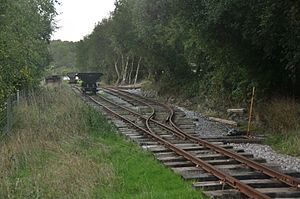
In 2014, the Purbeck Mining Museum made a plan with the Swanage Railway Trust. This plan was for the museum's future. It included opening the museum more often to get more visitors. It also aimed to let people see more parts of the museum. The first goal was to make the indoor displays better.
This plan is now finished. A main goal now is to fix the skew arch bridge over the Swanage Railway. This will allow access to Norden South. This means the museum can make its 2 ft (610 mm) wide railway longer. They could then run passenger trains and show how clay trains worked on special days. The museum also wants to build a home for Secundus and wagon 28. They plan to move them from Corfe Castle Station.
Museum Rolling Stock
All trains and wagons are 2 ft (610 mm) wide unless noted.
Steam Locomotives
| Number and name | Wheel arrangement |
Builder | Notes | Photograph |
|---|---|---|---|---|
| Secundus | 0-6-0WT | G. E. Belliss and Co. | 2 ft 8 in (813 mm) wide, not working. It is at Corfe Castle Station Goods shed. | 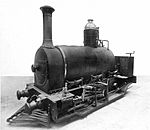 |
Diesel Locomotives
| Number and name | Wheel arrangement |
Class | Notes | Photograph |
|---|---|---|---|---|
| 283871 'Snapper' | 4wDM | 48DL Ruston Hornby Diesel | Being fixed up. | |
| 392117 | 4wDM | 48DL Ruston Hornby Diesel | Working, on loan to the museum. |
Carriages
| Number | Type | Notes | Photograph |
|---|---|---|---|
| - | 8 seater passenger carriage | Fixed up. | |
| - | 12 seater passenger carriage | Fixed up. |
Goods Wagons
| Number | Type | Notes | Photograph |
|---|---|---|---|
| - | 1 ft 10 in (559 mm) wide Underground mine tubs | 12 in total, being fixed up. | |
| 28 | 2 ft 8 in (813 mm) 4-wheeled wagon | Built for the Furzebrook Railway, waiting to be fixed up. | |
| - | Goathorn Wagon Flat | Working. | |
| - | Cement Mixer Wagon | Waiting to be fixed up. | |
| 140 | Hudson Skip | Being scrapped. | |
| 16 | Hudson Skip | Waiting to be fixed up. | |
| 41 | Allens Skip | Waiting to be fixed up. | |
| - | Allens Skip | Being fixed up. | |
| 31 | Flatbed | Waiting to be fixed up. | |
| 38 | Flatbed | Fixed up. | |
| - | Hudson Skip Chassis | Waiting to be fixed up. | |
| - | Hudson Skip Chassis | Fixed up. | |
| - | Small V skip | Waiting to be fixed up. | |
| - | Ballast forward tipper | Waiting to be fixed up. | |
| - | Drop sided wagon | Fixed up. | |
| - | Hudson Skip | Being fixed up. | |
| - | Small V skip | Waiting to be fixed up. | |
| - | Wide chassis wagon | Waiting to be fixed up. | |
| - | Wide chassis wagon | Waiting to be fixed up. | |
| - | Wide chassis wagon | Waiting to be fixed up. | |
| - | Ex RN Trecwn Explosive Wagon (Changed to PW van) | Fixed up. | |
| - | Hudson skip | Waiting to be fixed up. | |
| - | Lister bogie flatbed | Being fixed up. |


